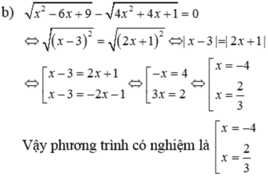

Hãy nhập câu hỏi của bạn vào đây, nếu là tài khoản VIP, bạn sẽ được ưu tiên trả lời.




a) Áp dụng bđt AM-GM có:
\(\sqrt[3]{\left(9-x\right).8.8}\le\dfrac{9-x+8+8}{3}=\dfrac{25-x}{3}\)\(\Leftrightarrow\sqrt[3]{9-x}\le\dfrac{25-x}{12}\)
\(\sqrt[3]{\left(7+x\right).8.8}\le\dfrac{7+x+8+8}{3}=\dfrac{23+x}{3}\)\(\Leftrightarrow\sqrt[3]{7+x}\le\dfrac{23+x}{12}\)
Cộng vế với vế \(\Rightarrow\sqrt[3]{9-x}+\sqrt[3]{7+x}\le4\)
Dấu "=" xảy ra khi \(\left\{{}\begin{matrix}9-x=8\\7+x=8\end{matrix}\right.\)\(\Rightarrow x=1\)
Vậy...
b)Đk:\(x\ge2\)
Pt \(\Leftrightarrow\left(x-1\right)^2.\left(x^2-4\right)=\left(x-2\right)^2.\left(x^2-1\right)\)
\(\Leftrightarrow\left(x-1\right)^2\left(x-2\right)\left(x+2\right)=\left(x-2\right)^2\left(x+1\right)\left(x-1\right)\)
Do \(x\ge2\Rightarrow x-1>0\)
Chia cả hai vế của pt cho x-1 ta được:
\(\left(x-1\right)\left(x-2\right)\left(x+2\right)=\left(x-2\right)^2\left(x+1\right)\)
\(\Leftrightarrow\left(x-2\right)\left[\left(x-1\right)\left(x+2\right)-\left(x-2\right)\left(x-1\right)\right]=0\)
\(\Leftrightarrow\left(x-2\right)\left[x^2+x-2-x^2+3x-2\right]=0\)
\(\Leftrightarrow\left(x-2\right)\left(4x-4\right)=0\)
\(\Leftrightarrow\left[{}\begin{matrix}x=2\left(tm\right)\\x=1\left(ktm\right)\end{matrix}\right.\)
Vậy S={2}
c)Đk:\(\left\{{}\begin{matrix}9-x^2\ge0\\x^2-1\ge0\\x-3\ge0\end{matrix}\right.\)\(\Leftrightarrow\left\{{}\begin{matrix}-3\le x\le3\\\left[{}\begin{matrix}x\ge1\\x\le-1\end{matrix}\right.\\x\ge3\end{matrix}\right.\)\(\Rightarrow x=3\)
Thay x=3 vào pt thấy thỏa mãn
Vậy S={3}
a) Quên mất, ko áp dụng đc AM-GM, xin lỗi
Pt \(\Leftrightarrow\sqrt[3]{9-x}-2=2-\sqrt[3]{7+x}\)
\(\Leftrightarrow\dfrac{9-x-8}{\sqrt[3]{\left(9-x\right)^2}+2\sqrt[3]{9-x}+4}=\dfrac{8-\left(7-x\right)}{4+2\sqrt[3]{7+x}+\sqrt[3]{\left(7+x\right)^2}}\)
\(\Leftrightarrow\dfrac{1-x}{\sqrt[3]{\left(9-x\right)^2}+2\sqrt[3]{9-x}+4}=\dfrac{1-x}{4+2\sqrt[3]{7+x}+\sqrt[3]{\left(7+x\right)^2}}\)
\(\Leftrightarrow\left[{}\begin{matrix}x-1=0\\\dfrac{1}{\sqrt[3]{\left(9-x\right)^2}+2\sqrt[3]{9-x}+4}=\dfrac{1}{4+2\sqrt[3]{7+x}+\sqrt[3]{\left(7+x\right)^2}}\end{matrix}\right.\)
\(\Leftrightarrow\left[{}\begin{matrix}x=1\\\sqrt[3]{\left(9-x\right)^2}+2\sqrt[3]{9-x}+4=4+2\sqrt[3]{7+x}+\sqrt[3]{\left(7+x\right)^2}\left(1\right)\end{matrix}\right.\)
Từ (1) \(\Leftrightarrow\sqrt[3]{\left(9-x\right)^2}-\sqrt[3]{\left(7+x\right)^2}+2\left(\sqrt[3]{9-x}-\sqrt[3]{7+x}\right)=0\)
\(\Leftrightarrow\left(\sqrt[3]{9-x}-\sqrt[3]{7+x}\right)\left(\sqrt[3]{9-x}+\sqrt[3]{7+x}\right)+2\left(\sqrt[3]{9-x}-\sqrt[3]{7+x}\right)=0\)
\(\Leftrightarrow\left(\sqrt[3]{9-x}-\sqrt[3]{7+x}\right).4+2\left(\sqrt[3]{9-x}-\sqrt[3]{7+x}\right)=0\)
\(\Leftrightarrow\sqrt[3]{9-x}-\sqrt[3]{7+x}=0\)
\(\Leftrightarrow\sqrt[3]{9-x}=\sqrt[3]{7+x}\)\(\Leftrightarrow9-x=7+x\)
\(\Leftrightarrow x=1\)
Vậy S={1}

a) đặc \(x^2=t\left(t\ge0\right)\)
pt \(\Leftrightarrow\) \(t^2-8t-9=0\)
\(\Delta'=\left(-4\right)^2-1\left(-9\right)\) = \(16+9=25>0\)
\(\Rightarrow\) phương trình có 2 nghiệm phân biệt
\(t_1=\dfrac{4+\sqrt{25}}{1}=9\left(tmđk\right)\)
\(t_2=\dfrac{4-\sqrt{25}}{1}=-1\left(loại\right)\)
\(t=x^2=9\) \(\Leftrightarrow\) \(x=\pm9\)
vậy \(x=\pm9\)


Câu 2/
Điều kiện xác định b tự làm nhé:
\(\frac{6}{x^2-9}+\frac{4}{x^2-11}-\frac{7}{x^2-8}-\frac{3}{x^2-12}=0\)
\(\Leftrightarrow x^4-25x^2+150=0\)
\(\Leftrightarrow\left(x^2-10\right)\left(x^2-15\right)=0\)
\(\Leftrightarrow\orbr{\begin{cases}x^2=10\\x^2=15\end{cases}}\)
Tới đây b làm tiếp nhé.
a. ĐK: \(\frac{2x-1}{y+2}\ge0\)
Áp dụng bđt Cô-si ta có: \(\sqrt{\frac{y+2}{2x-1}}+\sqrt{\frac{2x-1}{y+2}}\ge2\)
\(\)Dấu bằng xảy ra khi \(\frac{y+2}{2x-1}=1\Rightarrow y+2=2x-1\Rightarrow y=2x-3\)
Kết hợp với pt (1) ta tìm được x = -1, y = -5 (tmđk)
b. \(pt\Leftrightarrow\left(\frac{6}{x^2-9}-1\right)+\left(\frac{4}{x^2-11}-1\right)-\left(\frac{7}{x^2-8}-1\right)-\left(\frac{3}{x^2-12}-1\right)=0\)
\(\Leftrightarrow\left(15-x^2\right)\left(\frac{1}{x^2-9}+\frac{1}{x^2-11}+\frac{1}{x^2-8}+\frac{1}{x^2-12}\right)=0\)
\(\Leftrightarrow x^2-15=0\Leftrightarrow\orbr{\begin{cases}x=\sqrt{15}\\x=-\sqrt{15}\end{cases}}\)

b: Ta có: \(\sqrt{x^2-6x+9}-\dfrac{\sqrt{6}+\sqrt{3}}{\sqrt{2}+1}=0\)
\(\Leftrightarrow x^2-6x+9=3\)
\(\Leftrightarrow x^2-6x+6=0\)
\(\text{Δ}=\left(-6\right)^2-4\cdot1\cdot6=36-24=12\)
Vì Δ>0 nên phương trình có hai nghiệm phân biệt là:
\(\left\{{}\begin{matrix}x_1=\dfrac{6-2\sqrt{3}}{2}=3-\sqrt{3}\\x_2=3+\sqrt{3}\end{matrix}\right.\)